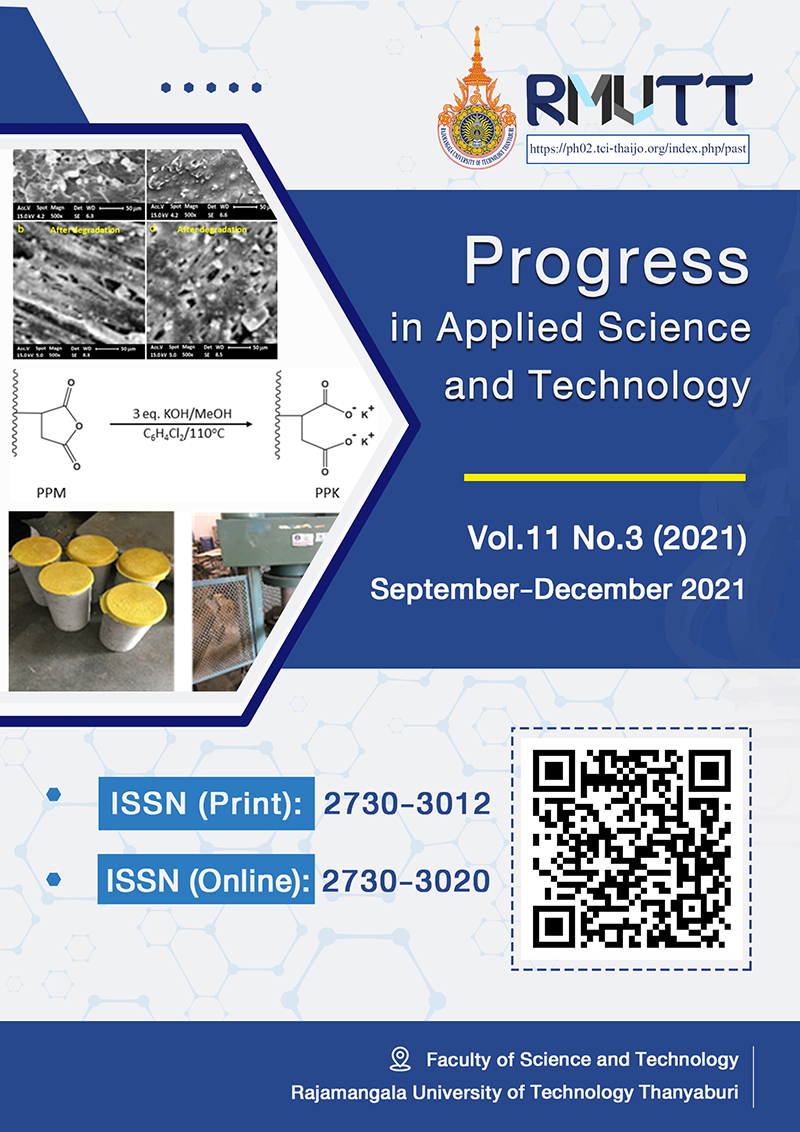Impact of Wet and Air Curing Methods on Developing Compressive Strength in Concrete
Main Article Content
Abstract
Concrete curing is a process fulfilling compressive strength value for the material used. There are several techniques to cure concrete, such as ponding or immersion, curing the mold, plastic sheeting, sprinkling or spraying, curing compounds, and steam curing. The principle is to provide sufficient moisture to the concrete structure during the hydration reaction. This research aims to study the effect on compressive strength development of concrete under curing conditions in wet and air. The compressive strength of the sample, which was cured by a different method, was investigated by comparing with the rising trend of curing time and water consumption in the improving compressive strength of concrete in each curing time. The cylindrical concrete samples of 10 cm diameter and 20 cm height were cast to evaluate compressive strength at the curing duration of 3, 5, 7, 14, 21, and 28 days as 60 samples. They were compared compressive strength with a different curing condition between room temperature (air curing) and wet curing. As ACI standards, controlled samples had a compressive strength of 350 kg/cm2 at 28 days of curing. The results revealed that the wet-cured samples had more compressive strength than the air-cured samples, as 359.26 kg/cm2 and 311.46 kg/cm2 after 28 days of curing. These were the highest value of compressive strength according to the increase in curing periods of 0 to 28 days. It indicated that moisture was a vital variable in the compressive strength development of concrete due to the hydration reaction.
Article Details

This work is licensed under a Creative Commons Attribution-NonCommercial-NoDerivatives 4.0 International License.
References
Justin M, Matthew S. Is the Risk of Sea Level Rise Capitalized in Residential Real Estate The Review of Financial Studies, 2020;33(3):1217–1255. https://doi.org/10.1093/rfs/hhz134.
Wallace W.-L. L., Xavier D.,Peter A,. A review of Ground Penetrating Radar application in civil engineering: A 30-year journey from Locating and Testing to Imaging and Diagnosis, NDT & E International, 2018; 96(1): 58-78, ISSN0963-8695,. https://doi.org/10.1016/j.ndteint.2017.04.002.
Chung, J. GULP regulates TGF-β responses in ovarian surface epithelial cells (Order No. 28254333). Available from ProQuest Dissertations & Theses Global. (2507167386). 2018. Retrieved from https://www.proquest.com/dissertations-theses/gulp-regulates-tgf-β-responses-ovarian-surface/docview/2507167386/se-2?accountid=32067.
Anish M. Varghese, Vikas M., in Biodegradable and Biocompatible Polymer Composites, 2018.
Chow, C.-F.; So, W.-M.W.; Cheung, T.-Y.; Yeung, S.K.D. Chapter 8: Plastic waste problem and education for plastic waste management. In Emerging Practices in Scholarship of Learning and Teaching in a Digital Era; Kong, S.C.; Wong, T.L.; Yang, M.; Chow, C.F; Tse, K.H, Ed; Springer Nature Pte Ltd.; Singapore, 2017; pp. 125-140.
Faraj, R.H.;Sherwani, A.F.H.;Daraei, A. Mechanical, fracture and durability properties of self-compacting high strength concrete containing recycled polypropylene plastic particles. Journal of Building Engineering2019, 25, https://doi.org/10.1016/j.jobe.2019.100808.
Bahij, S.; Omary, S.; Feugeas, F.; Faqiri, A. Fresh and hardened properties of concrete containing different forms of plastic waste – A review. Waste Management2020, 113, 157–175.
Awoyeraa, P.O.; Adesinab, A. Plastic wastes to construction products: Status, limitations and future perspective. Case Studies in Construction Materials 2020, 12, https://doi.org/10.1016/j.cscm.2020.e00330.
Madhu,G.,Bhunia,H.;Bajpai,P.K.; Chaudhary,V. Mechanical and morphological properties of high density polyethylene and poly-lactase blends. Journal of Polymer Engineering2014, 34(9), 813–821.
Ho BT, Roberts TK, Lucas S. An overview on biodegradation of polystyrene and modified polystyrene: the microbial approach. Crit. Rev. Biotechnol. 2018; 38 (2):308–320.
American Society for Testing and Materials. ASTM C136 / C136M-19, Standard Test Method for Sieve Analysis of Fine and Coarse Aggregates, ASTM International, West Conshohocken, PA, 2019.
American Society for Testing and Materials. ASTM C109/C109M-20a, Standard Test Method for Compressive Strength of Hydraulic Cement Mortars (Using 2-in. or [50-mm] Cube Specimens), ASTM International, West Conshohocken, PA, 2020.
American Society for Testing and Materials. ASTM C230 / C230M-14, Standard Specification for Flow Table for Use in Tests of Hydraulic Cement, ASTM International, West Conshohocken, PA, 2014.
Mustafa M. Al-Tayeb, Hanafi I., Osama Dawo, Sulaiman R. Wafi, Ismail Al Daoor, Ultimate failure resistance of concrete with partial replacements of sand by waste plastic of vehicles under impact load, International Journal of Sustainable Built Environment, Volume 6, Issue 2, 2017, Pages 610-616, ISSN 2212-6090, https://doi.org/10.1016/j.ijsbe.2017.12.008.
Abdeliazim M.M.,, Mohd A.M.A,, Hichem S., Mohd H.O., Performance evaluation of concrete with Arabic gum biopolymer, Materials Today: Proceedings, 2021; 39 (2). https://doi.org/10.1016/j.matpr.2020.04.576.
Wael E., Ahmed S., Rawaz K., Experimental Study Using ASTM and BS Standards and Model Evaluations to Predict the Compressive Strength of the Cement Grouted Sands Modified with Polymer, https://doi.org/10.1016/j.cscm.2021.e00600.
Moosa K., Ali A.R,Innovative air entraining and air content measurement methods for roller compacted concrete in pavement applications, Construction and Building Materials, 279(1), https://doi.org/10.1016/j.conbuildmat.2021.122495.
American Society for Testing and Materials. ASTM C128-15, Standard Test Method for Relative Density (Specific Gravity) and Absorption of Fine Aggregate, ASTM International, West Conshohocken, PA, 2015.
American Society for Testing and Materials. ASTM C29 / C29M-17a, Standard Test Method for Bulk Density (Unit Weight) and Voids in Aggregate, ASTM International, West Conshohocken, PA, 2017.
Rasooli A, Itard L, Ferreira CI A response factor-based method for the rapid in-situ determination of wall’s thermal resistance in existing buildings. Energ. Buildings 119: 51-61. 2016.
S. Fomin, S. Butenko, I. Plakhotnikova and S. Koliesnikov, Scientific Research Basics of Fire Resistance Testing for Rein-forced Concrete Structures and Buildings. Ma-terials Science Forum, [online].2020;1006(1), 158–165.. Available: https://doi.org/10.4028/www.scientific.net/msf.1006.158.
Wang R., Meyer C. Performance of cement mortar made with recycled high impact polystyrene. Cement Concrete Comp. 2012; 34, 975–981.
Saikia N, de Brito J. Use of plastic waste as aggregate in cement mortar and concrete preparation: A review. Construction and Building Materials. 2012; 34: 385-401.. https://doi.org/10.1016/j.conbuildmat.2012.02.066.
K. Hannawi, S. K. Bernard and W. Prince, Physical and mechani-cal properties of mortars containing PET and PC waste aggregates. Waste Management. [Online]. 2010;30(11), 2312–2320..Available:doi: 10.1016/j.wasman.2010.03.028.






